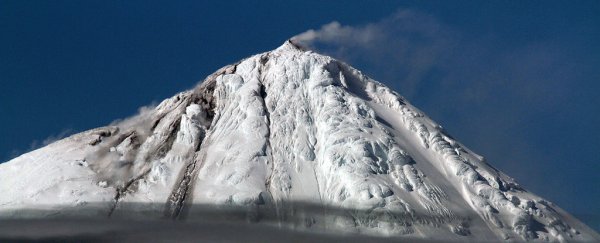Scientists have caught a rare glimpse of ice and fire, witnessing an eruption of the Big Ben volcano, situated on the remote Australian territory of Heard Island in the sub-Antarctic.
While Big Ben is known to have erupted at least three other times since 2000, catching the volcano massif in the act is extremely unlikely, given how truly removed Heard Island is. Lying some 4,099 kilometres (2,547 miles) southwest of Perth in Western Australia, and almost as far to the southeast of Madagascar, the island ranks among the most remote places on Earth – and researchers haven't set foot on it in almost 30 years.
Which makes it all the more serendipitous that scientists on board Australia's CSIRO research vessel, Investigator, on a voyage to the Kerguelen Plateau happened to observe the eruption, in addition to seeing volcanic activity at the neighbouring McDonald Islands – Australia's only other active volcano.
"Seeing vapour emanating from both of Australia's active volcanoes and witnessing an eruption at Mawson Peak have been an amazing coda to this week's submarine research," said the voyage's chief scientist, Mike Coffin of the Institute of Marine and Antarctic Studies. "We have 10 excited geoscientists aboard Investigator, and our enthusiasm has spread to our 50 shipmates."
 Pete Harmsen
Pete Harmsen
Seeing Big Ben's summit – the 2,745-metre (9,000 foot) tall Mawson Peak – in the act of erupting was particularly surprising to those on board, as inclement weather in the area (signs of which you can see in these photos) meant it was highly probable that the elevated peak wouldn't be visible at all.
"I'm doing my PhD on Heard Island volcanism, and to see lava emanating from Mawson Peak and flowing down the flank of Big Ben over a glacier has been incredible," said Jodi Fox, a student researcher at the University of Tasmania. "Given persistent cloud cover and generally foul weather, I didn't think we'd even see Mawson Peak on this voyage."
Using shipboard sonar systems, the researchers are imaging the seafloor and water column in the area looking for underwater plumes that could represent hydrothermal systems associated with active underwater volcanoes. Although less than halfway through their 58-day trip, the scientists have identified over 50 such potential plumes already.
But, despite the progress made so far, it's pretty clear what the most memorable highlight of the voyage is likely to be.
"Seeing land after being at sea for a couple of weeks is exciting, but to see dynamic Earth processes such as volcanoes erupting is an added bonus," said Coffin.

